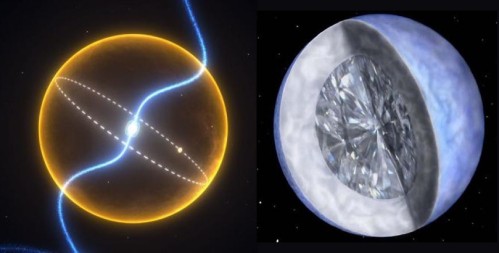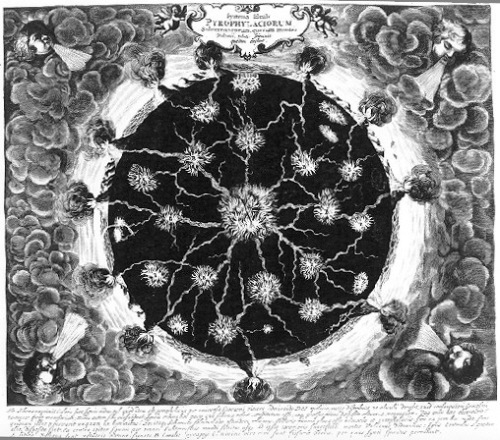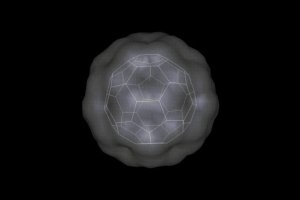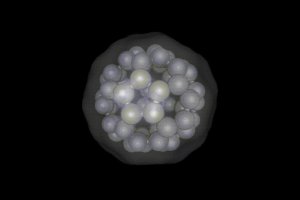Posts Tagged ‘Science’
Posted in culture, History, my wall, mysticism, Religion, Science, theology, tagged antiquities, carbon dating, Easter, faith, Jesus, religious relics, Science, Shroud of Turin on 03/30/2013| Leave a Comment »
Haeckel’s Radiolaria
Posted in my wall, sacred geometry, Science, tagged Bucky balls, Ernst Haeckel, Quadrivium, radiolaria, sacred geometry, Science, single-cell organisms, spheres on 08/25/2012| Leave a Comment »
_______________________________________________________________________________________________
Or, “Sacred Geometry in the Single Cells.” This video contains selections from the the film “Proteus”, a documentary concerning the life, work, and philosophy of naturalist Ernst Haeckel, (1834-1919). Haeckel was a German scientist who coined the phrase “ontogeny recapitulates phylogeny” and the terms “Darwinism” and “ecology.” He was first to postulate a “missing link” between ape and man and was proven correct when Java man was found in 1891. A staunch evolutionary biologist, Haeckel put Darwin on the world map. His books and monographs, placing Darwin in a broad social and philosophical context, were circulated internationally; they outsold On the Origin of Species by a large margin. Haeckel was commonly referred to as “the Darwin of Germany.”
Haeckel was also an accomplished artist. His idol was Goethe, who maintained that art as well as science could unearth the underlying truths of nature. For both Goethe and Haeckel, morphology had aesthetic roots. Haeckel traveled far and wide, from Sicily to Ceylon, to the North Sea, and beyond. Sketchpads and watercolors accompanied his microscope wherever he went. His on-the-spot drawings of deep-sea vegetation, aquatic creatures, frogs, birds, and higher animals were turned into more than 1000 engravings.
Sketchpads and watercolors accompanied his microscope wherever he went. His on-the-spot drawings of deep-sea vegetation, aquatic creatures, frogs, birds, and higher animals were turned into more than 1000 engravings.
The film tells of the man’s character and influences while using his detailed engravings of Radiolaria, single celled marine organisms, which also illustrate many of the shapes common in sacred geometry. Fascinating and beautiful!
Carbonaceous Coccolithophores
Posted in my wall, sacred geometry, Science, tagged algae, calcium carbonate, carbon, carbon cycle, Coccolithophores, coccoliths, oceanic, Quadrivium, sacred geometry, Science, spheres on 08/25/2012| Leave a Comment »
____________________________________________________________________
 Coccolithophores are microscopic algae that first appeared 220 million years ago, and flourished during the cretaceous period. They produce peculiar plates called cocoliths out of calcium carbonate, and incorporate them into
Coccolithophores are microscopic algae that first appeared 220 million years ago, and flourished during the cretaceous period. They produce peculiar plates called cocoliths out of calcium carbonate, and incorporate them into  an external shell. They constantly remove carbon from the atmosphere as they die and sink to the ocean floor, producing chalk. This is an important feedback system in the global carbon cycle.
an external shell. They constantly remove carbon from the atmosphere as they die and sink to the ocean floor, producing chalk. This is an important feedback system in the global carbon cycle.
I just think they look darn cool!
Spaceballs
Posted in Science, tagged achondrite, astrophysics, carbon, chondrite, iridium, iron meteorites, meteorite, minerology, mining, olivine, pallasite, peridot, planets, primitive meteorites, Science, silicate materials, silicate minerals, solar system on 08/17/2012| Leave a Comment »

__________________________________________________________________
Well, this blog is called “Star in the Stone” and that’s exactly what a pallasite is! How beautiful to reveal translucent gemstones welded into a molten mass. Peridot crystals can only be formed in outer space, brought down to earth in meteors.
There are three main types of meteorites.
 Those made entirely of iron alloy, are thought to be the cores of asteroids that melted early in their history. They consist mainly of iron-nickel metal with small amounts of sulphide and carbide minerals. Iridium,
Those made entirely of iron alloy, are thought to be the cores of asteroids that melted early in their history. They consist mainly of iron-nickel metal with small amounts of sulphide and carbide minerals. Iridium, is brittle, with a high melting point, similar to silver or platinum, an element very rare on earth, but often found in meteors. Most iron meteorites have a distinctive crystalline structure with bands containing low and high levels of nickel, known as Widmanstatten texture, which is highlighted when acid-etched.
is brittle, with a high melting point, similar to silver or platinum, an element very rare on earth, but often found in meteors. Most iron meteorites have a distinctive crystalline structure with bands containing low and high levels of nickel, known as Widmanstatten texture, which is highlighted when acid-etched.
 Second, there are those meteorites made of an iron-stone blend, called pallasites. These consist of almost equal amounts of iron-nickel metal and silicate minerals, and are amongst the most beautiful of meteorites, because of the gemstones they contain. Pallasites contain big, beautiful olive-green crystals, a form of magnesium-iron silicate called olivine, embedded entirely in metal. Pallasites can show big variations. Sometimes the olivine does not occur as a single crystal but as a cluster and elsewhere it can create a pattern of veins through solid metal.
Second, there are those meteorites made of an iron-stone blend, called pallasites. These consist of almost equal amounts of iron-nickel metal and silicate minerals, and are amongst the most beautiful of meteorites, because of the gemstones they contain. Pallasites contain big, beautiful olive-green crystals, a form of magnesium-iron silicate called olivine, embedded entirely in metal. Pallasites can show big variations. Sometimes the olivine does not occur as a single crystal but as a cluster and elsewhere it can create a pattern of veins through solid metal.
Third, are the stoney concretions, or chondrites, which consist mainly of silicate materials, such as olivine or feldspar, in conglomeration with iron or carbon. They are the most primitive meteorites in their chemical development. Chondrites come from asteroids that did not melt when formed. Carbonaceous chondrites often contain water-bearing minerals and compounds including the organic molecules such as amino acids, the building blocks of life on earth. Chondrites are the materials from which the solar system formed and have been little changed compared with rocks from the larger planets, which have been subjected to billions of years of geological activity. They are very similar in composition to the sun and can tell us a lot about how the solar system itself was formed. A variant of chondrite, called Achondrites include meteorites from asteroids, Mars and the moon. They are igneous, meaning that at some point they melted into magma. When the magma cools and crystallises,
Carbonaceous chondrites often contain water-bearing minerals and compounds including the organic molecules such as amino acids, the building blocks of life on earth. Chondrites are the materials from which the solar system formed and have been little changed compared with rocks from the larger planets, which have been subjected to billions of years of geological activity. They are very similar in composition to the sun and can tell us a lot about how the solar system itself was formed. A variant of chondrite, called Achondrites include meteorites from asteroids, Mars and the moon. They are igneous, meaning that at some point they melted into magma. When the magma cools and crystallises,  it creates a concentric layered structure, usually with metallic center and silicon coated exterior. This process is known as igneous differentiation,
it creates a concentric layered structure, usually with metallic center and silicon coated exterior. This process is known as igneous differentiation,
which gave rocky planets of Mercury, Venus, Earth and Mars them planetary crusts, mantles and cores. Achondrites can, therefore, tell us a lot about the internal structure and formation of the planets.
Lucy in the Sky with Diamonds
Posted in Science, tagged astrophysics, BPM 37093, carbon, CfA, diamond, gemstones, Lucy, mining, pulsar, Science, white dwarf on 08/15/2012| Leave a Comment »
Apparently this is old news now. However, I just recently heard of it, and find it fascinating. Here is the story of the largest known diamond in our galaxy.
 On Friday, 13th February, 2004, the Harvard-Smithsonian Centre for Astrophysics in Cambridge, Massachusetts, who study the origin, evolution and ultimate fate of the universe, released information about their latest discovery – a10 billion trillion trillion carat diamond.
On Friday, 13th February, 2004, the Harvard-Smithsonian Centre for Astrophysics in Cambridge, Massachusetts, who study the origin, evolution and ultimate fate of the universe, released information about their latest discovery – a10 billion trillion trillion carat diamond.
The newly discovered cosmic diamond is a chunk of crystallized carbon, the size of our Moon, 50 light-years from the Earth in the constellation Centaurus. It is 4000kms wide and weighs 5 million trillion trillion pounds or 10 billion trillion trillion carats.
“You would need a jeweller’s loupe the size of the Sun to grade this diamond!” says astronomer Travis Metcalfe who leads the team of researchers that discovered the giant gem. The diamond has been called ‘Lucy’ – a tribute to the Beatles song ‘Lucy In The Sky With Diamonds’, Technically known as BPM 37093, this huge cosmic gem, is actually a crystallized white dwarf. A white dwarf is the hot core of a star, left over after the star uses up its nuclear fuel and dies. It is made mostly of carbon and is coated by a thin layer of hydrogen and helium gases.
The white dwarf is not only radiant but also harmonious. It rings like a gigantic gong, undergoing constant pulsations. For more than four decades, astronomers have thought that the interiors of white dwarfs crystallized, but obtaining direct evidence became possible only recently. “The hunt for the crystal core of this white dwarf has been like the search for the Lost Dutchman’s Mine. It was thought to exist for decades, but only now has it been located,” says co-researcher Michael Montgomery.
The problem with proving the theory about the crystallization is that by the time the star has crystallized, it is no longer pulsating and is so cool, that they are impossible to detect. But BPM 37093 is so massive, that the star is crystallizing on the inside, as white light and sound continue to pulsate from the surface. The vibrations are detectable as colour shifts in the visible light emanating from the star. In this case, the right frequency makes it a diamond – blue green in tint.
“By measuring those pulsations, we were able to study the hidden interior of the white dwarf, just like seismograph measurements of earthquakes allow geologists to study the interior of the Earth. We figured out that the carbon interior of this white dwarf has solidified to form the galaxy’s largest diamond,” says Metcalfe.
Scientist Vince Ford, of the Australian National University’s Mount Stromio Observatory, said “This huge …..thing is sitting right down in the southern sky, in the constellation of Centaurus, just near the Southern Cross”. At approximately 4000kms in diameter, Lucy is roughly the same size as Australia and completely outclasses the largest diamond on Earth, the 530-carat Star of Africa that resides in the Crown Jewels of England. The Star of Africa was cut from the largest diamond ever found on Earth, a 3,100-carat gem.
Our Sun will also become a white dwarf when it dies 5 billion years from now. Some two billion years after that, the Sun’s ember core will crystallize as well, leaving a giant diamond in the centre of our solar system. The Sun is part of a group of stars called main sequence stars and most of these end their lives as white dwarves.
 Sirius B, which is a known white Dwarf star, will also be a diamond in the future. Sirius B is currently around 25,000 degrees on the surface, and will begin to crystallize when it has cooled to about half that temperature.
Sirius B, which is a known white Dwarf star, will also be a diamond in the future. Sirius B is currently around 25,000 degrees on the surface, and will begin to crystallize when it has cooled to about half that temperature.
______________________________________________________________
–reprised from Center for Astrophysics, Harvard-Smithsonian, 2-13-2004
It’s interesting to me, to imagine the possibility of somehow capturing this dead star and bringing it back to earth, where we value diamond as a rare commodity. Yet considering it’s great size, such an object brought to earth, would depreciate itself by its veritable massiveness. Scarcity is what increases value. A diamond the size of Australia, if it were suddenly available, would be about as worthless as the sand beneath our feet. Perhaps this is why the Aztecs couldn’t understand when the Spanish Conquistadors suddenly began to attack them for the gold adornments decorating their architecture and selves. Gold, readily available in South America, had no appreciable value for the local tribes in the sense it did as a rarity in Europe. One man’s trash is another man’s treasure. And vice versa, one man’s treasure is another man’s trash.
___________________________________________________________________________________________________________
Again Athanasius
Posted in my wall, sacred geometry, Science, technology, tagged aquifer, Athanasius Kircher, Bucky balls, geology, molecular, nano, particle, physics, Quadrivium, sacred geometry, Science, spheres, subterranean aquifers, vulcanology on 08/10/2012| Leave a Comment »
____________________________________________________________________________________________
A few posts back I mentioned I had originally been searching for images of those faces blowing wind, which you see on old maps. I came across these maps which happened to have been illustrated by Athanasius Kircher, who was a Benedictine scientist and authority of his time on many subjects, among them volcanology. It’s interesting to see the hypothetical depictions, circa 1668, of the views of how the earch was composed. By this time the world was known to be round. And although Jules Verne in the 19th century imagined that the core of the earth might be hollow, and even home to subterranean societies hidden from surface-dwellers, Kircher depicted the center as a seething pool of churning magma with various channels to the volcanos on the crust; which is basically accurate as we now know. He titled this piece “Pyrophylaciorum” for the fire in the middle. His second rendering depicts how water pools in subterranean depths all around the planet, the cavernous aquifers which feed the rivers at the surface, “Quo Exprimitur Aquarum”. It’s interesting that what he surmised, without being able to physically examine as we do today, with radar and ultrasound plumbing the depths. But in many ways his concepts were accurate.
The next phase in our physical understanding of our world would take us from deep within the earth, to deep within the physics of the atoms themselves. Unlike Kircher, who had no electronic means of detection, and relied on visual inspection, we now can journey deep inside matter itself. Leaping from models of atoms and molecules, we now can capture images of the particles inside of the atoms themselves, at the nano level, and even physically manipulate the atomic molecular arrangements. What’s interesting to me, is that at the micro levels of matter, patterns similar to those at the macro level are replicated reverse fractally, increasingly smaller Bucky balls of probability of energy and matter, time and empty space of particle physics….yet somehow patterned and predictable…
Which goes to show, that it is possible, to hear music in the spheres, and as the poem goes, to “see eternity in a grain of sand.”
____________________________________________________________________________________________
Playing with Toroidal Vortices
Posted in my wall, Science, tagged dolphins, doughnut shape, hydrogen bombs, Science, smoke rings, toroidal vortice, vortex, vortex motion, vortex ring, vortex rings, weird science on 06/08/2012| Leave a Comment »

_____________________________________________________________________
Extraordinary Toroidal Vortices
_____________________________________________________________________
Extraordinary and beautiful examples of toroidal vortices produced by dolphins, beluga whales, humpback whales, volcanoes, hydrogen bombs, and man.
A toroidal vortex, also called a vortex ring, is a region of rotating fluid moving through the same or different fluid where the flow pattern takes on a toroidal (doughnut) shape. The movement of the fluid is about the poloidal or circular axis of the doughnut, in a twisting vortex motion. Examples of this phenomenon are a smoke ring or a microburst.
Vortex rings were first mathematically analysed by the German physicist Hermann von Helmholtz, in his paper of 1867 On Integrals of the Hydrodynamical Equations which Express Vortex-motion. Wikipedia: Vortex Ring
In the category “weird science”, I found this footage absolutely captivating, fascinating and informative!
Jaguars eat lambs, don’t they?
Posted in Science, tagged Harlan Ellison, moistmedia, Roy Ascott, Science, technoetic, technology, telematic on 01/30/2010| Leave a Comment »
based upon “When the Jaguar Lies Down With the Lamb” by Roy Ascott
.
.
Scientists are optimists. With stars in their eyes, and “the-sky’s-the-limit” mentalities, they forge on their merry way, analyzing and dissecting the physical aspects and forces of nature of the world around us, like the courtiers in the old Chinese fable who would de-construct the mechanical songbird, but find it too difficult to put the original back together. Yet it is the hope, of the idealistic reconstruction of reality, that drives scientists to deconstruct the fabric of the universe, and accord humans a new place in it.
Puts forth Roy Ascott:
Just as globalisation means that not only are we are all connected, but that our ideas, institutions, even our own identities are constantly in flux, so too will moistmedia bridge the artificial and natural domains, transforming the relationship between consciousness and the material world.
Through advanced technologies we are evolving a double consciousness which allows us to perceive simultaneously the inward dynamic of things and their outward show……The crossovers between art, science, technology and mythology will mean that increasingly we live in the context of mixed reality…rubric of an emergent technology that deals concurrently with the virtual synthesized world…It creates environments that integrate both real and virtual worlds quite seamlessly.
Hold it right there. Doesn’t anyone remember the “Borg” on Star Trek the Next Generation? The “cybernetically enhanced” humanoid drones connected through wires and plasma membranes to the physical structure of their spaceship? Although the character Data demonstrated that intelligent androids could serve humans loyally–if programmed to–what about the robots who come to rule earth in “the Terminator”? Did the scientists who manufactured the first cyborg components at ‘Cyberdyne’ regret later what they thought of as progress?
 size-medium wp-image-680″ />As human consciousness expands with access to an expanding and shared database and cultural immersion in technology, at what point do humans retain their physical integrity as entities apart from a “Matrix”? Gene Rodenberry and Harlan Ellison seemed to remain skeptical of some scientific encounters with the future of human integration with technology.
size-medium wp-image-680″ />As human consciousness expands with access to an expanding and shared database and cultural immersion in technology, at what point do humans retain their physical integrity as entities apart from a “Matrix”? Gene Rodenberry and Harlan Ellison seemed to remain skeptical of some scientific encounters with the future of human integration with technology.
But Roy Ascott remains a perpetual optimist:
Just as telematic art celebrates the telenoia of world-wide connectivity (opposing the paranoia of the old industrial society), so moistmedia will provide new systems and structures to the emergent forms of planetary art, redefining the dynamic space of interaction and collaboration between artists of East and West, North and South, indeed of all regions of the world, however remote and hitherto unknown to each other. Poetry will always finally outlast oppression…Moistmedia is set to create a whole new post-biological universe, quite unlike the world as legislated on high in its authorised version with its apparently immutable laws.
I guess my skepticism that all “advancements” are unquestionably beneficial, makes me part of the “paranoia of the old industrial society”. That “Poetry will always finally outlast oppression”…well now that’s a nice thought, but the cybernetic drones upon the Borg might think otherwise.



![Kircher_[2]mundus subterraneus pyrophylaciorum](https://starinthestone.files.wordpress.com/2012/08/kircher_2mundus-subterraneus-pyrophylaciorum.jpg?w=500&h=446)
![Kircher_[3]mundus subterraneus pyrophylaciorum 1668](https://starinthestone.files.wordpress.com/2012/08/kircher_3mundus-subterraneus-pyrophylaciorum-1668.jpg?w=500&h=442)













